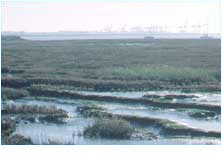|  This
analysis describes the characteristics and scale of the ports
sector and its impacts on the delivery of nature conservation
objectives in England. It gives English Nature's objectives for
the sector and sets out our three priority actions for 2003-2005.
We also identify the key organisations and actions needed to influence
policy and its delivery. This
analysis describes the characteristics and scale of the ports
sector and its impacts on the delivery of nature conservation
objectives in England. It gives English Nature's objectives for
the sector and sets out our three priority actions for 2003-2005.
We also identify the key organisations and actions needed to influence
policy and its delivery.
We outline the roles of the key shapers and players within the
sector. The dominant influences on this sector are government
departments, various regulatory bodies, commercial ports, harbour
authorities, the port trade associations and bodies representing
marine industry and leisure boating industries. English Nature's
role as an adviser in the regulatory process gives us influence,
but we need to complement this with positive initiatives to ensure
that we retain the cooperation of the industry.
We examine the key socio-economic and political factors that
shape the sector; these include the impact of privatisation, the
dual role of ports as public bodies and commercial companies,
the strong pressures for growth in some regions and sectors coupled
with the continuing decline in others. Other significant factors
are the volatility of markets and the fierce competition between
commercial ports in the UK and with some ports on the near continent,
and the continued growth of leisure boating.
We analyse the positive and negative nature conservation impacts
of the ports sector. The most serious conflicts arise through
competition for space within coastal and estuarine areas as some
ports and harbours, especially on the south and east coasts, seek
to expand or adapt to changing markets. On a more positive note,
the Habitats Regulations have engaged many ports in the process
of marine conservation management, and some harbour authorities
are developing a conservancy role. |

